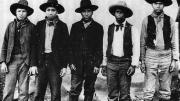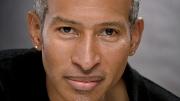In the summer of 1895, in the Indian Territory that became Oklahoma, a ragtag gang of five teenaged boys—all black, Native American, or of mixed race—went on a vicious two-week spree of robbery, rape, and murder. The apparently random violence terrified not only the local white settlers but also the neighboring Indians and African-American freedmen. But the violence wasn’t random. The gang’s leader, Rufus Buck, the 18-year-old son of a black mother and Creek father, burned with a zealot’s passion: he dreamed that his gang’s spree would trigger an Indian uprising that would expel the illegal white majority and reclaim the whole Territory for its native people.
That true story forms the basis for the 2011 novel I Dreamt I Was in Heaven: The Rampage of the Rufus Buck Gang, by Leonce Gaiter ’80. His fictional account (buckrampage.com) of the gang’s bloody tear through the dusty Indian country had its seeds in a clipping given to him 20 years earlier that included the only known photograph of the five outlaws. “They looked so young that it was quite shocking,” he says. “Some of them looked like babies. There was something incredibly compelling about that photograph, and I immediately felt, ‘My God, I would love to write about that.’”
Yet the writing came hard, and Gaiter, whose 2005 novel Bourbon Street is a noir tale set in 1958 New Orleans, made multiple false starts. Still, he did extensive historical research, mining century-old news clippings and court documents. “This was an extraordinarily difficult piece to get my head around,” he explains. “You have people who are doing horrible things, but you must understand why they are doing them. I’m not asking you to sympathize with their actions, but I want you to find their motives, given the personal and sociopolitical contexts, compelling. I wanted to create a dramatic story—I do write to entertain—but I also wanted a story that gives you a reason to read it. Not just something where you say afterwards, ‘Well, that was unpleasant.’”
He finally hit on the story’s rhythm, register, and key—a jazz buff, he says that “Music is my principal metaphor for everything”—by expanding its scope to include the politics of the Indian Territory and characters like the famous mixed-race outlaw Cherokee Bill (1876-1896), who was jailed in Fort Smith, Arkansas, when Buck was also incarcerated there. The deeply religious federal magistrate Isaac Parker (1838-1896), a “hanging judge” who ruled the judiciary in the area for decades and tried Buck’s gang, also plays a central role.
The fictional Theodosia Swain is the blonde, beautiful, and feral 13-year-old daughter of a white bourgeois widower, a thoroughly embittered ne’er-do-well from Mississippi whose world collapsed with that of the old South after the Civil War. When the Buck gang carries her off, she blithely accompanies them on their rampage—and the racial and sexual overtones of that reality both outrage and confound the white citizenry after the gang’s arrest.
The novel’s raw, unvarnished portrait of the Old West sounds and feels both grittier and more real than the place frequently seen in Hollywood Westerns and on television. For example, when the embryonic Buck gang starts selling liquor, they receive “three cases of brown whiskey in plain bottles that had been mixed with creek water and seasoned with chilies, tobacco, and a touch of strychnine to give it a much-appreciated kick.” The boys in the gang aren’t even faintly romantic villains, but lost, dimwitted, unloved souls staggering clumsily through the world, creating havoc not from evil plans but from sheer teenage impetuosity. When the gang steals some horses from a livery stable, for example, one boy heedlessly tosses a lantern onto a pile of hay as they leave, setting the building ablaze, nearly incinerating two other horses left behind, and eventually burning down half the small town.
The gang embodies a dangerous combination: a volatile, high-testosterone mix of young male energy with no meaningful channel (or future), lethal weapons, and an evangelical, simplistic, dogmatic ideology. It has much in common, in other words, with today’s terrorist cells and extremist paramilitary groups. “Rufus’s trajectory, the quasi-religious mania that inspires his mission, has a template,” Gaiter says, “and that template fits religious zealots, from John Brown to Saint Paul. If you want to consider them all crazy, you can—but some of these crazy people have changed the world.”
Rufus Buck (“Even his name sounds like a criminal’s,” Gaiter notes) did not change the world. But the author says he went down “fighting for his identity. What was done to the Indians was as brutal as what Rufus did.” Buck’s victims were mostly unlucky whites the gang happened on (though his first murder is that of a black U.S. marshal), but “people alight with righteous rage go after symbols of their oppression,” Gaiter explains, “not the people who’ve done the actual harm.”
Gaiter himself is an African American, from a military family with New Orleans roots. He concentrated in visual and environmental studies and says he spent “thousands of hours” listening to jazz and classical music in the Loeb Music Library. He has lived most of his adult life in California, first in Los Angeles, where he was a story analyst for CBS and a paralegal for A & M Records. Now he lives in a “horsey community”near Sacramento, where he works as director of marketing for a technological company—and rides horses. “That’s something I never thought I’d do,” he says. “Own horses.”
Reflecting on his novel, he says, “The history of African-American letters is largely a history of people who take the outside world’s condemnation and destroy themselves by turning it inward. Native Son, Invisible Man, Beloved—these are all people who take the hatred that is spewed at them and internalize it. I got sick of reading those books, because they suggest a passive, pathetic people, which I know I am not from. The fact that these teenagers were fighting back—as a black man, that meant a great deal to me. Win or lose, right or wrong, they went out fighting, and that matters.”










